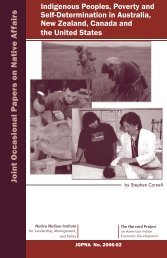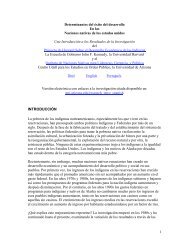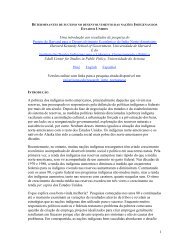American Indian Self-Determination - Native Nations Institute ...
American Indian Self-Determination - Native Nations Institute ...
American Indian Self-Determination - Native Nations Institute ...
- No tags were found...
You also want an ePaper? Increase the reach of your titles
YUMPU automatically turns print PDFs into web optimized ePapers that Google loves.
<strong>American</strong> <strong>Indian</strong> <strong>Self</strong>-<strong>Determination</strong>Stephen CornellJoseph P. Kaltjudicially enunciated “trust obligation.” Under this doctrine, the federalgovernment is duty-bound as protector of financial and naturalresource assets, which are held in trust on behalf of tribes and individual<strong>Native</strong> <strong>American</strong>s. In particular, through the trust relationship,the federal government continues to have responsibility for economicdevelopment via regulation, including protection of the inalienability, oftribal trust lands.U.S. policy recognizes that, as trustee on behalf of <strong>Indian</strong> Tribes, thefederal government has an explicit, fundamental interest in furtheringthose policies that promote the social and economic health and wellbeingof <strong>Native</strong> <strong>American</strong> communities. 33 As noted, from the advent ofthe reservation system in the late 1880s until the latter half of the 20 thcentury, the governance of <strong>American</strong> <strong>Indian</strong> nations was largely underthe direct control of the U.S. federal government.Whether originally via the War Department in the 19 th century oreventually via the BIA and other federal agencies, the federal governmentwas largely responsible for deciding, implementing, and controllingthe economic, political, and social decisions confronting <strong>Indian</strong>nations and their citizens. 34 As discussed above, by any measure, thisapproach led to continued socio-economic deprivation amongst tribesand their citizens and, thus, failed to meaningfully satisfy the federalgovernment’s trustee responsibilities for the well-being of <strong>Native</strong><strong>American</strong>s and failed to meet the objectives of tribal self-sufficiencyand socio-economic well-being. Policy change began in the late 1960sand early 1970s. The substantive meaning, as reflected both in formalacts and proclamations and in the actual course and conduct of federalpolicy, of the federal interest in tribal self-determination is nowexpressed as tribal self-governance and economic self-reliance.The move toward policies of tribal self-determination began in the1960s with the passage of the Economic Opportunity Act of 1964. ThisAct sought to address poverty by seeking to empower those subjectto economic and social deprivation to control their own affairs. As itrelated to <strong>Native</strong> <strong>American</strong>s, the effect was to bypass the traditionalfederal bureaucracy by placing federal monies directly in the hands oftribal governments, thus giving tribal governments and other triballybased organizations control over the resources in question. 3517







